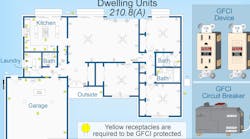How can you determine the ampacity of conductors and apply adjustment factors, based on the requirements in Secs. 310-10?
The ampacities of conductors vary depending on their conditions of use and exposure to surrounding ambient temperatures. This article covers how to determine the ampacity of conductors, based on the requirements in Sec. 310-10, Fine Print Notes (FPNs) (1) through (4).
The conductor ampacities listed in Tables 310-16 through 310-19 are based on four determining factors:
- Ambient temperature;
- Internal conductor heat (based on load current);
- Rate of heat dissipation; and
- Effect of adjacent load carrying conductors.
Let's explore each of these in more detail.
Sec. 310-10, FPN (1). If the temperature surrounding the conductor (along its entire length) varies from 86øF (30øC), the allowable ampacity as listed in Table 310-16 shall be corrected, according to the correction factors noted below the Table.
For example, three current-carrying copper conductors in a raceway exposed to a 40øC (104øF) ambient temperature shall have their ampacities derated by 91%. However, ambient temperature will not affect the ampacity of conductors if that portion of the conductor routed through the higher ambient zone is 10 ft or less and does not exceed 10% of the total length of such conductors (per Sec. 310-15(a)(2), Ex.).
Sec. 310-10, FPN (2). To comply with this rule, size the ampacity of a conductor to carry the load without overheating its insulation beyond the listed temperature per Table 310-13 and Table 310-16. A properly sized conductor serves as a heat sink to remove heat away from the terminals of devices and equipment. To ensure conductors are adequately sized to supply the load without overheating its insulation, you must compute the loads per Sec. 210-19(a) for branch-circuits and Sec. 215-2(a) for feeder-circuits.
Continuous loads shall have a full-load current increase of 125%. Then, you add this value to noncontinuous loads at 100% or to demand factors, if any such loads are present.
Sec. 310-10, FPN (3). If you don't select the ampacities of conductors according to the lowest temperature rating of devices and equipment, the higher temperatures in the insulation will deteriorate internal working parts.
If you connect a conductor with 90øC insulation to a terminal rated 60øC, you must heat the 90øC insulation above 90øC before heat can dissipate into the surrounding ambient medium. Matching the 90øC ampacity of the conductor to the 60øC ampacities of the overcurrent protection device and equipment limits the unwanted heating effects of internal components (see Fig. 4).
Sec. 310-10, FPN (4). The proximity heating effect of conductors occur where you bundle or pull conductors together in raceways or cables. When you install conductors in this manner, you reduce their ability to dissipate heat. You must apply adjustment factors per Sec. 310-15(b)(2)(a) to compensate for such heating and to prevent damage to insulation and components of devices and equipment.
If you pull four or more current-carrying conductors (0V to 2000V) through a raceway or bundle in a cable for a distance greater than 24 in., you'll reduce (derate) the allowable ampacity of such conductors by the factors (percentages) listed in Table 310-15(b)(2)(a).
For example, nine current-carrying conductors in a raceway shall have their ampacities listed in Table 310-16 reduced by 70%, so their insulation rating will not overheat if they should ever become fully loaded.


